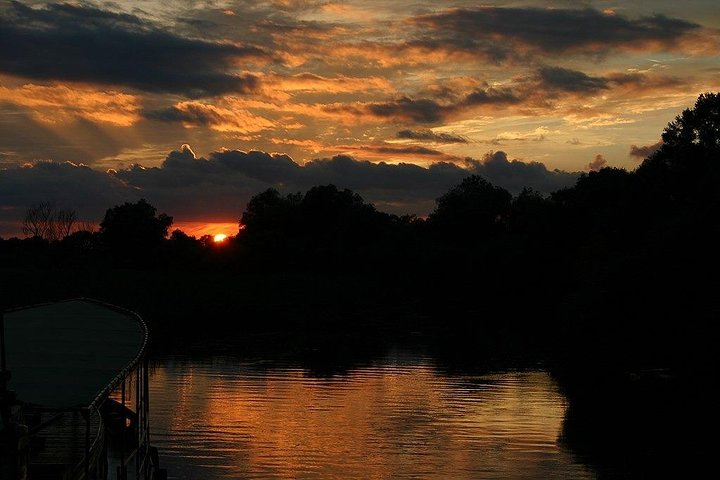The Danube Delta Biosphere Reserve is recognized globally for its rich ecosystem and is designated as a UNESCO World Heritage Site. This Delta is a haven for birdwatchers, with over 300 bird species documented. In terms of biodiversity, it ranks third in the world, following Australia’s Great Barrier Reef and Ecuador’s Galapagos Islands.
The Danube Delta Biosphere Reserve is recognized globally for its rich ecosystem and is designated as a UNESCO World Heritage Site. This Delta is a haven for birdwatchers, with over 300 bird species documented. In terms of biodiversity, it ranks third in the world, following Australia’s Great Barrier Reef and Ecuador’s Galapagos Islands.
Bucharest to Tulcea
Tulcea County - Central Eco-Tourism Museum of the Danube Delta
Top choice museum in Tulccea
This combined museum and aquarium is a good primer on the delta’s varied flora and fauna. There are stuffed animals on the main floor and a small but fascinating aquarium on the lower level, with ample signage in English. Highly…
Bucharest to Tulcea
Tulcea County - Central Eco-Tourism Museum of the Danube Delta
Top choice museum in Tulccea
This combined museum and aquarium is a good primer on the delta’s varied flora and fauna. There are stuffed animals on the main floor and a small but fascinating aquarium on the lower level, with ample signage in English. Highly recommended if you’re traveling with kids and want to get the most out of your visit.
Tulcea - Tulcea (pronounced Tool’cha) is an old city in the historical region of Dobrogea, Romania and is the administrative center of Tulcea county. It has a population of about 92,000 and has been an important harbor since ancient times since it is where the famous Danube river finally ends its journey through Europe as it empties into the Black sea creating the famous Danube Delta.
The town has successively been under Byzantine (5th - 7th century), Genoese (10th - 13th century) and Ottoman rule before finally being reunited with Romania in 1878.
Tulcea is busiest in August and December, when its regular festivals take place: the International Folk Festival of the Danubian Countries, held in odd-numbered years, and an annual winter carnival.
The local Lipovani Russian and Turkish minorities lend the city a multi-ethnic flavora.
Letea Forest Boat Tur in the beauty of Danube Delta
Letea Forest - With wild horses, vines, 700 year old oak trees and sand dunes, Letea is the northern most subtropical forest in the world. Hidden away from the eyes and paths of most tourists, the forest has numerous secrets which it carefully guards.To get here, you have to cross through a myriad of canals, all covered with water lilies. Once you’re getting close, you’ll see the fishermen’s boats and the church tower in the village.
The people who live in Letea are mostly Russians, while those in the neighboring village of CA Rosetti Romanians and in Periprave Lipovans.
Many of them believe that the land on top of which the village was built used to be the bottom of the sea which rose up to the surface a long time ago. A local legend even says that they once found a washed away ship under the dunes, with only the top of the mast sticking out. While the story is beautiful, the genesis of the Danube delta is somewhat different.
Sulina Beach - Sulina is a town and a free port in Tulcea county, Dobrogea, at the eastern extremity of Romania, the Danube Delta, the mouth of the Sulina branch point in the Black Sea. It has a population of 4601 inhabitants. Sulina is not directly related to road network in Romania and can be reached only by water or on the Danube or Black Sea.
Danube Delta - The Danube River is the most international river on the planet - its course runs across — or forms a part of the borders of several countries: Germany, Austria, Slovakia, Hungary, Croatia, Serbia, Romania, Bulgaria, Ukraine, and four capitals: Vienna, Bratislava, Budapest and Belgrade.Formed over a period of more than 10,000 years, the Danube Delta continues to grow due to the 67 million tons of alluvia deposited every year by the Danube River.
» The Delta is formed around the three main channels of the Danube, named after their respective ports: Chilia (in the north), Sulina (in the middle), and Sfantu Gheorghe (in the south).
» The Danube Delta Biosphere Reserve has the third largest biodiversity in the world (over 5,500 flora and fauna species), exceeded only by the Great Barrier Reef in Australia and the Galapagos Archipelago in Ecuador.
» The Danube Delta is home to over 60% of the world’s population of pygmy cormorants (phalacrocorax pygmeus), 50% of red-breasted geese (branta ruficollis) and the largest number of white pelicans (pelecanus onocrotalus) and Dalmatian pelicans (pelecanus crispus) in Europe.
» It also is home to the world’s largest reed bed expanse – 625, 000 acres / 240,000 ha.
» Some 15,000 people inhabit the Delta area, living in 28 villages and one city (Sulina).
» The area was first attested by Herodot of Halicarnas (484 – 425 B.C.).
» More then half of the Delta Biosphere Reserve is virtually intact.

- Travel guide
- Private transportation
- Speed boat transfer
- Horse cart from Letea Village to Letea Forest
- Traditional fish lunch at Letea Village
- Sulina Tour and beach session
- Travel guide
- Private transportation
- Speed boat transfer
- Horse cart from Letea Village to Letea Forest
- Traditional fish lunch at Letea Village
- Sulina Tour and beach session
- Lunch,dinner
- Lunch,dinner
For a full refund, cancel at least 24 hours before the scheduled departure time.
For a full refund, cancel at least 24 hours before the scheduled departure time.

















